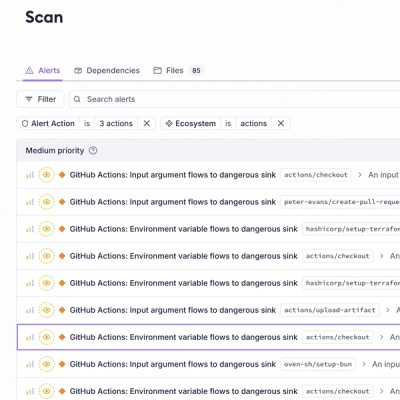
Product
Introducing Socket Firewall Enterprise: Flexible, Configurable Protection for Modern Package Ecosystems
Socket Firewall Enterprise is now available with flexible deployment, configurable policies, and expanded language support.
feedsmeFeedsme is a micro service that receive build completion notifications from carpenterd. When these notifications are received we will try to find all dependent modules on the package that was just build and send them in for re-build in carpenterd.
This ensures that all dependencies on your packages are always updated.
git clone git@github.com:godaddy/feedsme.git
cd feedsme && npm install
The module provides a bin/server script that starts the
service. Run the service with npm.
npm start
When carpenterd queues a build it will trigger a POST /change on the Feedsme
microservice with the package.json contents of the package that was built. The
package.json is then processed in a few ways to allow tracking and triggering of
dependent packages to be built. To make it concrete, a dependent package of
package A would be package B if B has A as a dependency. So now if a new
version of A is published, a dependent build will be triggered for B to get
the changes made to A. The latest work we have done to this project, creating
a release-line data structure ensures that this is safely based on the given
semver ranges. Lets start to get into the specifics
release-lineA release-line encapsulates the association between package A, and the
version it was published as along with the associated package B with its
auto-incremented version that was published as a result of this system. With
every publish we now know for certain which version of package B will be
promoted along side package A as we move from DEV -> TEST -> PROD.
The first step of processing a change event is to resolve the Dependent
packages of the package sent to feedsme as well as resolve any possible
DependentOf packages. We do this currently by inspecting the dependencies in the
given package, and seeing which ones are also managed by warehouse. From this
filtered list of packages, we then create the dependent mapping. The dependency
itself being the root or parent package like A is above and the dependent
being the child, similar to package B. Dependents is a lookup for the parent
Package which has an array of the packages that depend on it.
DependentOf is the inverse of Dependent and rather than an array, assumes
a single value. We don't allow there to be multiple parent packages for a given
dependent. So the DependentOf record is created with the lookup being the
dependency itself, like package B with the dependentOf value being the
parent or package A.
These lookup tables are then used in the next step.
release-line with dependentOfWe now use these lookup tables to make decisions around triggering dependent
packages and/or adding a dependent to the given release-line. Here we have
a 2 different scenarios that influence our course of action.
We are a publish, this is the only time a release-line is created for the given package and is also the only time a release-line can have a dependent added to it. This is because new versions only happen in DEV.
If we are a package that has dependents, this is the only time the version of the dependent package gets automatically incremented based on the version of the parent package and the semver range of the dependent's dependency on the parent package. It is also possible to not build dependents in DEV if we have detected that a manual publish of the dependent package(s) is(are) essential due to the semver range of the dependent's dependency on the parent package.
We are a promotion from DEV -> TEST or TEST -> PROD. We implicitly use
the release-line versions created on the initial publish of the package to
use for promoting the correct version of dependent packages.
Below we have diagrams of specific cases that we handle.
The premise for this diagram is that we have a package child@5.0.0 that
depends on package root@^5.0.0. From here we go through a sequence of
publishes and promotions via the typical warehouse system workflow.

Cassandra should be running local. It can be installed through homebrew for MacOS or run the docker container from docker hub.
npm test
4.0.3
DATABASE_REGION env var to define dynamo regionFAQs
A changes feed micro service
The npm package feedsme receives a total of 59 weekly downloads. As such, feedsme popularity was classified as not popular.
We found that feedsme demonstrated a not healthy version release cadence and project activity because the last version was released a year ago. It has 6 open source maintainers collaborating on the project.
Did you know?

Socket for GitHub automatically highlights issues in each pull request and monitors the health of all your open source dependencies. Discover the contents of your packages and block harmful activity before you install or update your dependencies.

Product
Socket Firewall Enterprise is now available with flexible deployment, configurable policies, and expanded language support.

Security News
Open source dashboard CNAPulse tracks CVE Numbering Authorities’ publishing activity, highlighting trends and transparency across the CVE ecosystem.

Product
Detect malware, unsafe data flows, and license issues in GitHub Actions with Socket’s new workflow scanning support.